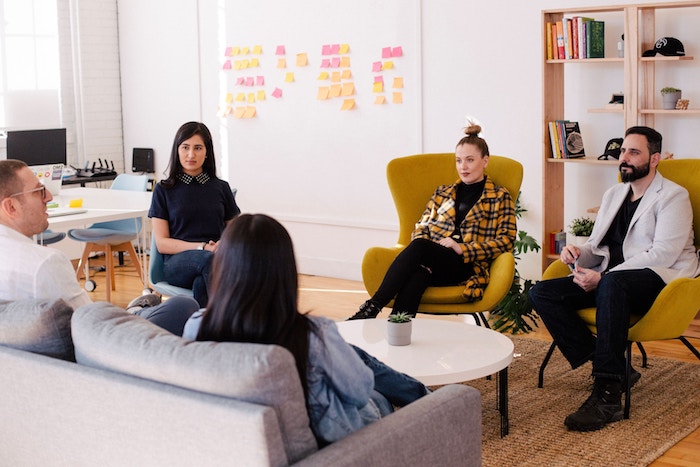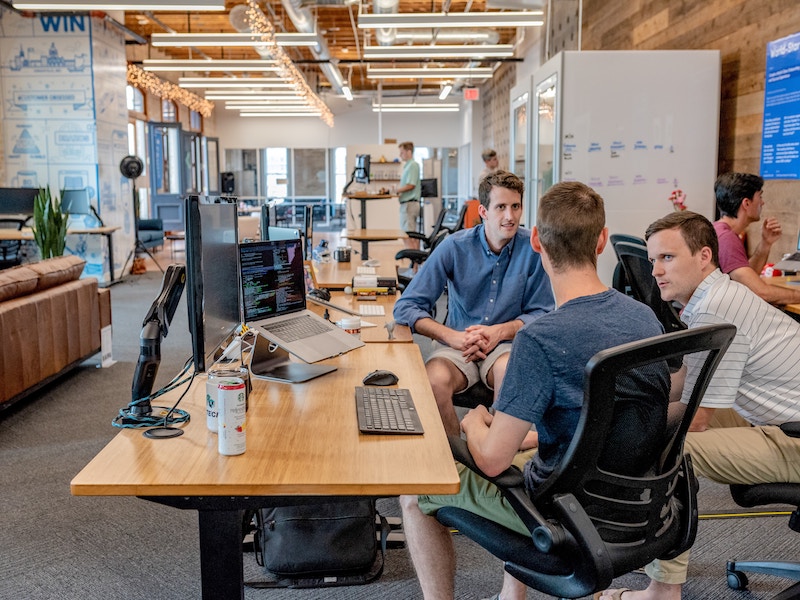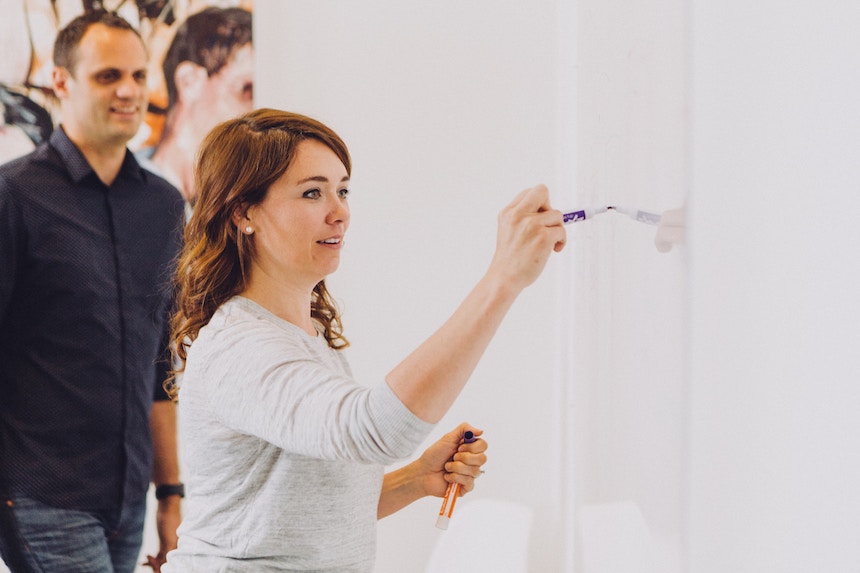Creative thinking is a valuable skill and can help you stand out and produce great results. Read on for a list of proven ways to increase your creativity.
I recently wrote about my trip to Vermont to visit my aunt and uncle.
While there, I visited their art studios. I lounged in their home full of art. We drove through the countryside. We visited with friends. We browsed in bookstores.
And I went for a walk in the woods.
It was during this walk that I had the idea to explore the value of creativity in the workplace.
I don’t fully poo-poo the value of creativity. I have my own creative side projects. I’ve made giant paper mache heads for a Mardi Gras party. I make candles for fun with my sister. I’ve quilted. I made my daughter’s Halloween costumes when she was little.
But work feels very different to me. Work has always felt like it needed to be a more serious space. More analytical, and less creative.
But during that walk in the woods, I started thinking about the role of creativity at the office. And how it might play a bigger role than I give it credit for.

When I got back to the house, I brought up the topic for discussion. Both Aunt Mallory and Uncle Harry come from the business world, so they were the perfect conversation partners for this discussion.
They quickly helped me understand that creative thinking is extremely valuable in work and business, and I wrote a post on that very topic.
But now that you know how important creativity is to business and your work, I wanted to give you ways to actually tap into that power.
Creative Thinking and The Importance of Workplace Culture

When I approached the topic of creativity with Aunt Mallory, she immediately brought up the topic of workplace culture. As a consultant, she had experience working in many different corporate and business environments.
Mallory explained, “When I was working with corporations closely, sometimes creativity was not encouraged. It can vary depending on your management, regulations, structure, and mindset. It used to be risky to be creative.”
The workplace culture can dictate whether creativity is allowed or encouraged. Many workplace cultures discourage creativity in favor of the status quo. Mallory pointed out that the culture needs to ask, “Is it encouraged by management or not?”
Much of whether a workplace taps into creativity is the way work is done. If everything is run by following formal and rigid processes and procedures, and no one pushes against the norm, very little creativity emerges. There’s a lot of emphasis on creating and standardizing the way most things are done in an organization. And while that can increase efficiency and safety, it can stifle creativity.
And creativity can not only challenge the norms but can be threatening to some. Conference rooms are filled with “yes” men, and new ideas are frowned upon.
You can’t encourage people to be creative if it’s not valued.
People aren’t encouraged to be creative at work if it’s not valued as part of the culture.
And yet, creativity can be extremely valuable in the workplace. Billion-dollar businesses are built from creative solutions to problems (hello, Spanx.)
And you’ll stand out if you’re able to generate creative ideas and approaches in your workplace.
How to cultivate creative thinking

When I asked Harry and Mallory about ways to cultivate creativity in the workplace, Harry responded with a question: “Are you referring to creativity from an individual or group approach?”
Hmm…it’s a valid question. It’s worth looking at both approaches. So I’ve broken it out into two approaches – individual and group activity.
Look over each list, and try them all. See what works best for you.
Developing Individual Creative Thinking
Favorite approaches to inspire creativity can vary from person to person. Give each a try and see which you prefer. You may find several favorites!
1. Mediation and clearing your mind to allow other things to come in.

You have to make space for creative ideas to emerge.
Aunt Mallory pointed out, “If you’re so consumed with the minutiae of the day you won’t allow for anything else to come in.”
I firmly believe this. If I’m feeling overwhelmed and stuck, meditation allows me to get clarity.
I can sit with an idea, and usually, I’ll see things from a different perspective.
Studies have been done on meditation and how it can aid in the creative process. It works by allowing your brain to step away from working so hard on the problem and allowing ideas to synchronize and integrate different pieces of information for new ideas.
If you’re a complete newbie to meditating, these super simple instructions will get you started.
The key is to keep it simple and don’t worry about sitting for a long time – just enough that you can actually do it. Four minutes may be the perfect amount for you to get started.
You can do this at home or at work. Any place you won’t be disturbed.
Meditation for Creative Thinking – How to do it:
- Sit comfortably.
- Close your eyes (or leave them half-open if needed.)
- Breathe in and out calmly and focus on your breath and how your body feels.
- Allow your breathing to slow down as you begin to get calmer.
- When your thoughts start to wonder, simply notice it, observe the thought without getting involved in it, and let it go, and bring your mind back to your breathing.
- As you finish, gently bring your mind back to focus on everything around you.
There – you’ve completed your first meditation! As you do it more, you’ll find at times you have insights and creative ideas that will surface without effort.
I often suggest that my coaching clients and Project Management Career Launch students incorporate this as part of their strategy simply because I have so much success with it in my personal experience.
2. Movement

I find my mind is sharper when I incorporate exercise and movement into my day.
The epiphanies don’t always come during the exercise, but sometimes they do. The idea for this blog topic surfaced during a walk. The idea for a beautifully simple approach to help a client understand a challenging, abstract concept came during a run.
But I always find the cognitive benefits last longer than the exercise itself.
Lots of different types of exercise can help. But even simply taking a walk can have a positive impact on creative output. There are multiple ideas on why this is so, and it’s not yet fully understood. But don’t let that stop you from getting the benefit of movement on creative thinking.
All truly great thoughts are conceived by walking.
Friedrich Nietzsche
Movement for Creative Thinking – How to do it:
- Take a walk.
- Go for a run.
- Stretch.
- Do yoga.
- Go for a bike ride.
- Swim.
3. Making unusual connections can prompt new ideas.

To stimulate creativity, take two unrelated objects and try to come up with as many connections or uses for the combined objects as you can. Right now I’m looking at a salt shaker and a pen. For the exercise, I could do a mash-up of these two and think up new ways to modify them for something combined or different. For example, the way the top screws off the salt shaker makes me think of having a secret compartment in my pen to hide tiny treasures. Or the shape of the salt shaker makes me think that we could change the shape of the pen and use it as a dispenser for something other than ink.
My current favorite real-world application of this approach is the seat heaters in my car.
Making Unusual Connections for Creative Thinking – How to do it:
- Pick out two random items in your current line of vision.
- Combine elements of them and come up with as many ideas for new uses or products – no matter how silly.
4. Alternate uses

Studies show that using divergent thinking such as finding alternate uses for items can lead to creative results. And furthermore, the more ideas you generate, the more creative they get. Studies show that earlier ideas may all be common, but the latter ideas get more unique and creative. So aim for quantity here.
Alternate Uses – How to do it:
- Pick a random item and come up with as many alternate uses for the item as you can.
- To get the most creative, keep going even when you think you’ve finished.
5. Changing Your Environment
If you find you’re getting stuck or churning on an idea without moving forward, changing your environment can help.
Changing surroundings can get you unstuck and spur new ideas.
Sometimes simply changing the location is all you need to get moving forward again with fresh ideas.
Changing Location for Creative Thinking – How to do it:
- Assess what you’ll need to be able to do your work and not be disturbed. Is it a power outlet? Wifi? A whiteboard?
- Find that spot, get there, and get creative!
6. Generating ideas prompts you to have more ideas.
James Altucher suggests to write down ten ideas per day, even if they’re bad ideas. He swears it’s like building a muscle and will help you generate more ideas.
Generating Ideas for Creative Thinking: How to Do It:
- Consistency is key to this exercise.
- Get a small notebook you can carry with you or one you’ll use at home at the same time each day.
- Every day, write down ten ideas. These don’t need to be GOOD ideas – simply ideas.
- James Altucher goes on to suggest that you also write down the first step (ONLY the first step) you’d take to implementing each.
- The next day – repeat.
7. Expose yourself to new experiences.
This can be anything from locations to literature.
Exposing yourself to new ideas, new environments, new experiences allows you to have a broader base of resources for making creative connections.
In the short-term, get out of your normal surroundings and expose yourself to something new.
Exposing Yourself to New Experiences – How to Do It:
Do anything to get out of your normal routine, such as any of the following:
- Drive a different route to work.
- Read a magazine you’d never have considered.
- Go to a market you’ve never been to.
- Eavesdrop on people at the next table at a café.
- Go to a new café you’ve never been to.
- Try a cuisine you’ve never tried.
- Go to an art gallery.
- Go to a part of town you’ve never been to. Get out of the car and walk around.
- Go to a festival – even a small, local festival will give you new experiences.
8. Stay curious.
Don’t approach everything with a closed mind or preconceived notions. Be open to new ideas and be on the lookout constantly for the way things work.
Whether you’re going about your regular routine or trying something new, be open to exploring what the experience has to offer.
My superpower is talking to strangers. My daughter says it’s super annoying. But I find that I learn so much by exposing myself to new ideas presented by people I’ve not yet met.
Staying curious for Creative Thinking – How to Do It:
- When trying any of the items listed above, or going about your regular routine, stay open to the experience. When someone cuts you off in traffic or does something to upset you, instead of having a knee-jerk reaction and assuming you know everything about the situation, ask yourself questions about it. “I wonder where they’re going in such a hurry. Could someone be delivering a baby in the back of that car right this minute?”
- When meeting someone, ask questions to draw out information.
- Even eavesdropping as mentioned below could apply here. One morning I overheard the following conversation between an elderly man and woman on stationary bicycles:
Her: I’m making banana bread with nuts.
Him: I can’t eat nuts.
Her in a tut-tut tone of voice: Well, why not?!
Him: I don’t have teeth.
Sure, I’ll likely never use that in my writing – oh wait…I just did.
Stimulating Group Creativity
Creative ideation doesn’t have to be done as a solo activity. There are approaches you can use in groups to come up with unique ideas or better solutions.
I’ve listed several here. Some may be obvious, and some may be newer to you.
1. Collaboration

Talking with others can help you see things differently and prompt creative perspectives. Sharing ideas, getting feedback, getting input, and creating with the inspiration of others can help you make something even better than it might have been in isolation.
Authors have been known to use this technique.
J.R.R. Tolkien and C.S. Lewis were members of the Inklings. Ernest Hemmingway, F. Scott Fitzgerald, James Joyce, Ezra Pound, And Gertrude Stein were members of Stratford on Odeon – named for their meeting place.
And sharing ideas and collaborating is not limited to writers and artists. Socrates, Plato, and others used this approach to discuss big ideas which helped them make important contributions to philosophy.
Even in my writing, sometimes I’m inspired by a comment that someone may make in passing, inspiring me to want to dig deeper and collaborate.
2. Play

I mentioned “play” above in the list for individual creativity, but it can be used in groups, too.
Play at work can create an atmosphere that allows team members to have the rapport and confidence needed to be more creative.
You can use improv activities such as “Yes, and…” or even offsite play activities.
Or use the awesome icebreakers mentioned in this post.
Using fun meeting icebreakers can help groups develop rapport. They can also help teams relax and be willing to try new things or share creative ideas.
3. Asking Questions

When you ask open-ended questions, you prompt others to think and to share ideas and information with you.
Use this approach to learn something new, push ideas further, and generate creative solutions you wouldn’t have thought of on your own.
4. Brainstorming

There are many brainstorming techniques your team or organization can use. These can help generate many ideas and move the group toward new ideas.
5. Creating Challenges and Competition

Both Frankenstein and Dracula were the results of Lord Byron setting a challenge to a group of friends on holiday in Switzerland.
Byron, Mary Shelly, Percy Bysshe Shelley, and John Polidori read ghost stories, and Byron challenged each member of the group to write a ghost story and they would vote on the winner. Had they not had this group competition, neither of these classics may have been born.
Some companies have innovation challenges. Many good ideas are born out of these events.
Try creating your own creative challenge with your team and see what great results you get.
Helpful Tips To Keep in Mind
When using these activities to inspire creative thinking, keep the following points in mind.

Know yourself and your working style
For some, creativity and stress don’t reside in the same space, but some people thrive on stress.
One person may thrive on stress to inspire them to come up with out-of-the-box ideas.
And another may need to spend more time with something. They may need to take the time to understand an issue, then step away, let it simmer, and emerge with new ideas.

Understand that it doesn’t always emerge.
Sometimes you do it consciously and sometimes it just appears.
Harry pointed out “It’s hard to say “I’m going to be creative. Sometimes it comes up during the process of whatever you’re attacking.”
But don’t be hard on yourself if it doesn’t happen at the very moment you try to command it.

People can get so emotionally invested they get stuck.
If you’re working in a group, understand that sometimes people get so invested in their idea that they can’t be open to other ways of doing things. They get emotionally invested in an idea and can’t let go of it.
Be aware if you’ve got someone in your group that exhibits this tendency.
SUMMARY
With technology and trends moving faster than ever, slowing down to employ creative thinking can benefit your organization and your career.
There are many ways to inspire creative thinking, whether you want to do it alone or in a group.
Approach it with enjoyment and openness, in an environment open to creative ideas, and you’ll likely come away with some wonderful results.
